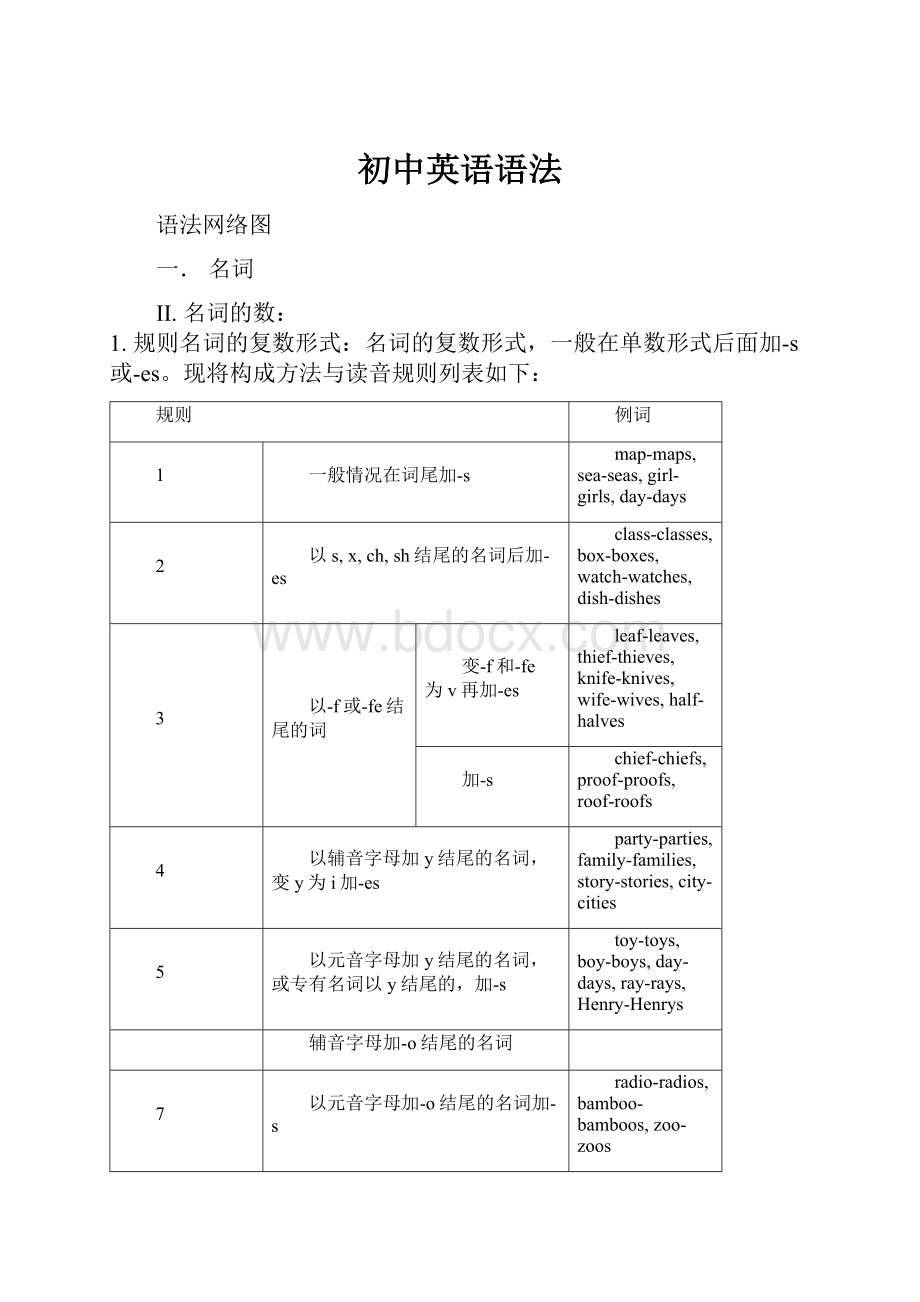 初中英语语法.docx
初中英语语法.docx
- 文档编号:29803927
- 上传时间:2023-07-27
- 格式:DOCX
- 页数:25
- 大小:30.52KB
初中英语语法.docx
《初中英语语法.docx》由会员分享,可在线阅读,更多相关《初中英语语法.docx(25页珍藏版)》请在冰豆网上搜索。

初中英语语法
语法网络图
一.名词
II.名词的数:
1.规则名词的复数形式:
名词的复数形式,一般在单数形式后面加-s或-es。
现将构成方法与读音规则列表如下:
规则
例词
1
一般情况在词尾加-s
map-maps,sea-seas,girl-girls,day-days
2
以s,x,ch,sh结尾的名词后加-es
class-classes,box-boxes,watch-watches,dish-dishes
3
以-f或-fe结尾的词
变-f和-fe为v再加-es
leaf-leaves,thief-thieves,knife-knives,
wife-wives,half-halves
加-s
chief-chiefs,proof-proofs,roof-roofs
4
以辅音字母加y结尾的名词,变y为i加-es
party-parties,family-families,story-stories,city-cities
5
以元音字母加y结尾的名词,或专有名词以y结尾的,加-s
toy-toys,boy-boys,day-days,ray-rays,Henry-Henrys
辅音字母加-o结尾的名词
7
以元音字母加-o结尾的名词加-s
radio-radios,bamboo-bamboos,zoo-zoos
8
以-th结尾的名词加-s
truth-truths,mouth-mouths,month-months,path-paths
2.不规则名词复数:
英语里有些名词的复数形式是不规则的,现归纳如下:
规则
例词
2
单复数相同
sheep,deer,means,works,fish
3
只有复数形式
trousers,clothes,thanks,goods,glasses,
4
一些集体名词总是用作复数
people,police
5
部分集体名词既可以作单数(整体)也可以作复数(成员)
class,family,crowd,couple,group,government,population,team,public,party
7
表示“某国人”
加-s
Americans,Australians,Germans,Greeks,Swedes,Europeans
单复数同形
Swiss,Portuguese,Chinese,Japanese
二.冠词
冠词分为不定冠词(a,an),定冠词(the),和零冠词。
I.不定冠词的用法:
1
指一类人或事,相当于akindof
Aplaneisamachinethatcanfly.
2
第一次提及某人某物,非特指
Aboyiswaitingforyou.
3
表示“每一”相当于every,one
Westudyeighthoursaday.
4
表示“相同”相当于thesame
Wearenearlyofanage.
5
用于人名前,表示不认识此人或与某名人有类似性质的人或事
AMr.Smithcametovisityouwhenyouwereout
ThatboyisratheraLeiFeng.
6
用于固定词组中
Acoupleof,abit,onceuponatime,inahurry,haveawalk,manyatime
7
用于quite,rather,many,half,what,such之后
Thisroomisratherabigone.
8
用于so(as,too,how)+形容词之后
Sheisascleveragirlasyoucanwishtomeet.
II.定冠词的用法:
1
表示某一类人或物
Thehorseisausefulanimal.
2
用于世上独一无二的事物名词前
theuniverse,themoon,thePacificOcean
3
表示说话双方都了解的或上文提到过的人或事
Wouldyoumindopeningthedoor?
4
用于乐器前面
playtheviolin,playtheguitar
5
用于形容词和分词前表示一类人
thereach,theliving,thewounded
6
表示“一家人”或“夫妇”
theGreens,theWangs
7
用于序数词和形容词副词比较级最高级前
Heisthetallerofthetwochildren.
8
用于国家党派等以及江河湖海,山川群岛的名词前
theUnitedStates,theCommunistPartyofChina,theFrench
9
用于表示发明物的单数名词前
ThecompasswasinventedinChina.
10
在逢十的复数数词之前,指世纪的某个年代
inthe1990’s
12
用于方位名词,身体部位名词,及表示时间的词组前
Hepattedmeontheshoulder.
III.零冠词的用法:
1
专有名词,物质名词,抽象名词,人名地名等名词前
BeijingUniversity,Jack,China,love,air
3
季节,月份,星期,节假日,一日三餐前
March,Sunday,NationalDay,spring
4
表示职位,身份,头衔的名词前
LincolnwasmadePresidentofAmerica.
5
学科,语言,球类,棋类名词前
Helikesplayingfootball/chess.
6
与by连用表示交通工具的名词前
bytrain,byair,byland
7
以and连接的两个相对的名词并用时
husbandandwife,knifeandfork,dayandnight
三.代词:
I.代词可以分为以下七大类:
1
人称代词
主格
I,you,he,she,it,we,you,they
宾格
me,you,him,her,it,us,you,them
2
物主代词
形容词性
my,your,his,her,its,our,their
名词性
mine,yours,his,hers,its,ours,theirs
3
反身代词
myself,yourself,himself,herself,itself,ourselves,yourselves,themselves
4
指示代词
this,that,these,those,such,some
5
疑问代词
who,whom,whose,which,what,whoever,whichever,whatever
6
关系代词
that,which,who,whom,whose,as
7
不定代词
one/some/any,each/every,none/no,many/much,few/little/afew/alittle,
other/another,all/both,neither/either
II.不定代词用法注意点:
1.one,some与any:
1)one可以泛指任何人,也可特指,复数为ones。
some多用于肯定句,any多用于疑问句和否定句。
Oneshouldlearntothinkofothers.
Haveyouanybookmarks?
No,Idon’thaveanybookmarks.
Ihavesomequestionstoask.
2)some可用于疑问句中,表示盼望得到肯定的答复,或者表示建议,请求等。
Wouldyoulikesomebananas?
Couldyougivemesomemoney?
3)some和any修饰可数名词单数时,some表示某个,any表示任何一个。
Ihavereadthisarticleinsomemagazine.
Pleasecorrectthemistakes,ifany.
4)some和数词连用表示“大约”,any可与比较级连用表示程度。
Therearesome3,000studentsinthisschool.
Doyoufeelanybettertoday?
2.each和every:
each强调个别,代表的数可以是两个或两个以上,而every强调整体,所指的数必须是三个或三个以上。
Eachstudenthasapocketdictionary./Each(ofus)hasadictionary./Weeachhaveadictionary.
Everystudenthasstrongandweakpoints./Everyoneofushasstrongandweakpoints.
3.none和no:
no等于notany,作定语。
none作主语或宾语,代替不可数名词,谓语用单数,代替可数名词,谓语单复数皆可以。
Thereisnowaterinthebottle.
Howmuchwateristhereinthebottle?
None.
Noneofthestudentsare(is)afraidofdifficulties.
4.other和another:
1)other泛指“另外的,别的”常与其他词连用,如:
theotherday,everyotherweek,someotherreason,nootherway,
theother特指两者中的另外一个,复数为theothers。
如:
Heheldabookinonehandandhisnotesintheother.
Twostudentsinourclassfailed,butalltheotherspassedtheexam.
2)another指“又一个,另一个”无所指,复数形式是others,泛指“别的人或事”如:
Idon’tlikethisshirt,pleaseshowmeanother(one).
Thetrousersaretoolong,pleasegivemeanotherpair/someothers.
Somelikefootball,whileotherslikebasketball.
5.all和both,neither和either
all表示不可数名词时,其谓语动词用单数。
both和all加否定词表示部分否定,全部否定用neither和none.
AllofthebooksarenotwritteninEnglish./NotallofthebooksarewritteninEnglish.
Bothofusarenotteachers./Notbothofusareteachers./Eitherofusisateacher.
四.形容词和副词
I.形容词:
1.形容词的位置:
1)形容词作定语通常前置,但在下列情况后置:
1
修饰some,any,every,no和body,thing,one等构成的复合不定代词时
nobodyabsent,everythingpossible
2
以-able,-ible结尾的形容词可置于有最高级或only修饰的名词之后
thebestbookavailable,theonlysolutionpossible
3
alive,alike,awake,aware,asleep等可以后置
theonlypersonawake
4
和空间、时间、单位连用时
abridge50meterslong
6
形容词短语一般后置
amandifficulttogetonwith
2)多个形容词修饰同一个名词的顺序:
性状形容词
性质
状态
大小
长短
形状
新旧
温度
颜色
国籍
产地
材料
质地
名词
beautiful
good
poor
large
short
square
new
cool
black
yellow
Chinese
London
silk
stone
III.形容词和副词比较等级:
比较级和最高级的构成一般是在形容词和副词后加-er和-est,多音节和一些双音节词前加more和most。
1.同级比较时常常用as…as…以及notso(as)…as…如:
Iamnotsogoodaplayerasyouare.
2.可以修饰比较级的词有:
much,many,alot,even,far,abit,alittle,still,yet,byfar,any,agreatdeal。
3.表示一方随另一方变化时用“themore…themore…”句型。
如:
Theharderyouwork,themoreprogressyouwillmake.
4.用比较级来表达最高级的意思。
如:
Ihaveneverspentamoreworryingday.
5.表示倍数的比较级有如下几种句型:
Ourschoolisthreetimeslargerthan/aslargeas/fourtimesthesizeofyours.
6.表示“最高程度”的形容词没有最高级和比较级。
如:
favorite,excellent,extreme,perfect。
五.介词
II.常用介词区别:
1
表示时间的in,on,at
at表示片刻的时间,in表示一段的时间,on总是与日子有关
2
表示时间的since,from
since指从过去到现在的一段时间,和完成时连用,from指从时间的某一点开始
3
表示时间的in,after
in指在一段时间之后,after表示某一具体时间点之后或用在过去时的一段时间中
4
表示地理位置的in,on,to
in表示在某范围内,on指与什么毗邻,to指在某环境范围之外
5
表示“在…上”的on,in
on只表示在某物的表面上,in表示占去某物一部分
6
表示“穿过”的through,across
through表示从内部通过,与in有关,across表示在表面上通过,与on有关
7
表示“关于”的about,on
about指涉及到,on指专门论述
8
between与among的区别
between表示在两者之间,among用于三者或三者以上的中间
9
besides与except的区别
besides指“除了…还有再加上”,except指“除了,减去什么”,不放在句首
10
表示“用”的in,with
with表示具体的工具,in表示材料,方式,方法,度量,单位,语言,声音
11
as与like的区别
as意为“作为,以…地位或身份”,like为“象…一样”,指情形相似
12
in与into区别
in通常表示位置(静态),into表示动向,不表示目的地或位置
六.动词
I.动词的时态:
1.动词的时态一共有16种,以ask为例,将其各种时态的构成形式列表如下:
现在时
过去时
将来时
过去将来时
一般
ask/asks
asked
shall/willask
should/wouldask
进行
am/is/areasking
was/wereasking
shall/willbeasking
should/wouldbeasking
完成
have/hasasked
hadasked
shall/willhaveasked
should/wouldhaveasked
完成进行
have/hasbeenasking
hadbeenasking
shall/willhavebeenasking
should/wouldhavebeenasking
2.现在完成时与一般过去时的区别:
1)现在完成时表示过去发生的动作或存在的状况,但和现在有联系,强调的是对现在造成的影响或结果,它不能同表示过去的时间状语连用,汉译英时可加“已经”等词。
简言之,利用过去,说明现在。
如:
Ihavealreadyreadthenovelwrittenbytheworld-famouswriter.(已经看过,且了解这本书的内容)
2)一般过去时只表示过去发生的动作或状态,和现在无关,它可和表示过去的时间状语连用,汉译英时可加“过”,“了”等词。
简言之,仅谈过去,不关现在。
如:
Ireadthenovellastmonth.(只说明上个月看了,不涉及现在是否记住)
IlivedinBeijingfortenyears.(只说明在北京住过十年,与现在无关)
3.现在完成时与现在完成进行时的区别:
两者都可以表示“从过去开始一直持续到现在”,在含义上如着重表示动作的结果时,多用现在完成时,如着重表示动作一直在进行,即动作的延续性时,则多用现在完成进行时。
一般不能用于进行时的动词也不能用于现在完成进行时。
Ihavereadthatbook.我读过那本书了。
Ihavebeenreadingthatbookallthemorning.我早上一直在读那本书。
4.一般将来时的表达方式:
将来时
用法
例句
1
will/shall+动词原形
表示将来发生的动作或存在的状态
Mysisterwillbetennextyear.
2
begoingto+动词原形
含有“打算,计划,即将”做某事,或表示很有可能要发生某事
It’sgoingtoclearup.
We’regoingtohaveapartytonight.
3
be+doing进行时表示将来
go,come,start,move,leave,arrive等词可用进行时表示按计划即将发生的动作
Heismovingtothesouth.
AretheyleavingforEurope?
4
beaboutto+动词原形
表示安排或计划中的马上就要发生的动作,后面一般不跟时间状语
Iwasabouttoleavewhenthebellrang.
Themeetingisabouttoclose.
5
beto+动词原形
表示按计划进行或征求对方意见
We’retomeetattheschoolgateatnoon.
6
一般现在时表示将来
时刻表上或日程安排上早就定好的事情,可用一般现在时表示将来
Themeetingstartsatfiveo’clock.
Theplaneleavesattenthisevening.
II.动词的被动语态:
常用被动语态
构成
常用被动语态
构成
1
一般现在时
am/is/areasked
6
过去进行时
was/werebeingasked
2
一般过去时
was/wereasked
7
现在完成时
have/hasbeenasked
3
一般将来时
shall/willbeasked
8
过去完成时
hadbeenasked
4
过去将来时
should/wouldbeasked
9
将来完成时
will/wouldhavebeenasked
5
现在进行时
am/is/arebeingasked
10
含有情态动词的
can/must/maybeasked
注
意
事
项
被动语态的否定式是在第一个助动词或情态动词后加not,短语动词的被动态不可漏掉其中介副词。
固定结构be
goingto,usedto,haveto,hadbetter变为被动态时,只需将其后的动词变为被动态。
如:
Treesshouldnotbeplantedinsummer./Theboywasmadefunofbyhisclassmates.
Newspapersusedtobesentherebythelittlegirl.
汉语有一类句子不出现主语,在英语中一般可用被动结构表示。
如:
Itisbelievedthat…
Itisgenerallyconsideredthat…
Itissaidthat…
Itiswellknownthat…
Itmustbepointedoutthat…
Itissupposedthat…
Itisreportedthat…
Itmustbeadmittedthat…
Itishopedthat…
下面主动形式常表示被动意义:
如:
Thewindowwants/needs/requiresrepairing.
Thebookisworthreadingtwice.
Thedoorwon’tshut./Theplaywon’tact.
Theclotheswasheswell./Thebooksellswell.
Thedishtastesdelicious./Waterfeelsverycold.
下面词或短语没有被动态:
leave,enter,reach,become,benefit,cost,equal等等
七.情态动词
I.
情态动词基本用法:
情态动词
用法
否定式
- 配套讲稿:
如PPT文件的首页显示word图标,表示该PPT已包含配套word讲稿。双击word图标可打开word文档。
- 特殊限制:
部分文档作品中含有的国旗、国徽等图片,仅作为作品整体效果示例展示,禁止商用。设计者仅对作品中独创性部分享有著作权。
- 关 键 词:
- 初中英语 语法
 冰豆网所有资源均是用户自行上传分享,仅供网友学习交流,未经上传用户书面授权,请勿作他用。
冰豆网所有资源均是用户自行上传分享,仅供网友学习交流,未经上传用户书面授权,请勿作他用。


 《贝的故事》教案4.docx
《贝的故事》教案4.docx
 幼儿园年检工作总结汇报ppt优质PPT.pptx
幼儿园年检工作总结汇报ppt优质PPT.pptx
 外勤管理规定表格文件下载.xls
外勤管理规定表格文件下载.xls
